An official website of the United States government
 United States Department of Labor
United States Department of Labor
Transport patients to areas such as operating rooms or x-ray rooms using wheelchairs, stretchers, or moveable beds. May maintain stocks of supplies or clean and transport equipment. Excludes "Nursing Assistants" (31-1131). Psychiatric orderlies are included in "Psychiatric Aides" (31-1133).
Employment estimate and mean wage estimates for Orderlies:
| Employment (1) | Employment RSE (3) |
Mean hourly wage |
Mean annual wage (2) |
Wage RSE (3) |
|---|---|---|---|---|
| 43,570 | 1.9 % | $ 15.28 | $ 31,780 | 0.5 % |
Percentile wage estimates for Orderlies:
| Percentile | 10% | 25% | 50% (Median) |
75% | 90% |
|---|---|---|---|---|---|
| Hourly Wage | $ 10.70 | $ 12.35 | $ 14.44 | $ 17.56 | $ 21.42 |
| Annual Wage (2) | $ 22,260 | $ 25,680 | $ 30,030 | $ 36,530 | $ 44,550 |
Industries with the highest published employment and wages for Orderlies are provided. For a list of all industries with employment in Orderlies, see the Create Customized Tables function.
Industries with the highest levels of employment in Orderlies:
| Industry | Employment (1) | Percent of industry employment | Hourly mean wage | Annual mean wage (2) |
|---|---|---|---|---|
| General Medical and Surgical Hospitals | 35,530 | 0.63 | $ 15.28 | $ 31,770 |
| Nursing Care Facilities (Skilled Nursing Facilities) | 1,680 | 0.11 | $ 12.64 | $ 26,290 |
| Offices of Physicians | 1,270 | 0.05 | $ 15.46 | $ 32,160 |
| Outpatient Care Centers | 970 | 0.10 | $ 19.78 | $ 41,150 |
| Colleges, Universities, and Professional Schools | 580 | 0.02 | $ 16.09 | $ 33,470 |
Industries with the highest concentration of employment in Orderlies:
| Industry | Employment (1) | Percent of industry employment | Hourly mean wage | Annual mean wage (2) |
|---|---|---|---|---|
| General Medical and Surgical Hospitals | 35,530 | 0.63 | $ 15.28 | $ 31,770 |
| Specialty (except Psychiatric and Substance Abuse) Hospitals | 570 | 0.21 | $ 15.09 | $ 31,380 |
| Facilities Support Services | 310 | 0.19 | $ 14.47 | $ 30,090 |
| Nursing Care Facilities (Skilled Nursing Facilities) | 1,680 | 0.11 | $ 12.64 | $ 26,290 |
| Outpatient Care Centers | 970 | 0.10 | $ 19.78 | $ 41,150 |
Top paying industries for Orderlies:
| Industry | Employment (1) | Percent of industry employment | Hourly mean wage | Annual mean wage (2) |
|---|---|---|---|---|
| Outpatient Care Centers | 970 | 0.10 | $ 19.78 | $ 41,150 |
| Psychiatric and Substance Abuse Hospitals | 240 | 0.10 | $ 19.10 | $ 39,730 |
| Home Health Care Services | 80 | 0.01 | $ 18.23 | $ 37,910 |
| Local Government, excluding schools and hospitals (OEWS Designation) | 190 | (7) | $ 18.19 | $ 37,840 |
| State Government, excluding schools and hospitals (OEWS Designation) | 450 | 0.02 | $ 16.62 | $ 34,560 |
States and areas with the highest published employment, location quotients, and wages for Orderlies are provided. For a list of all areas with employment in Orderlies, see the Create Customized Tables function.
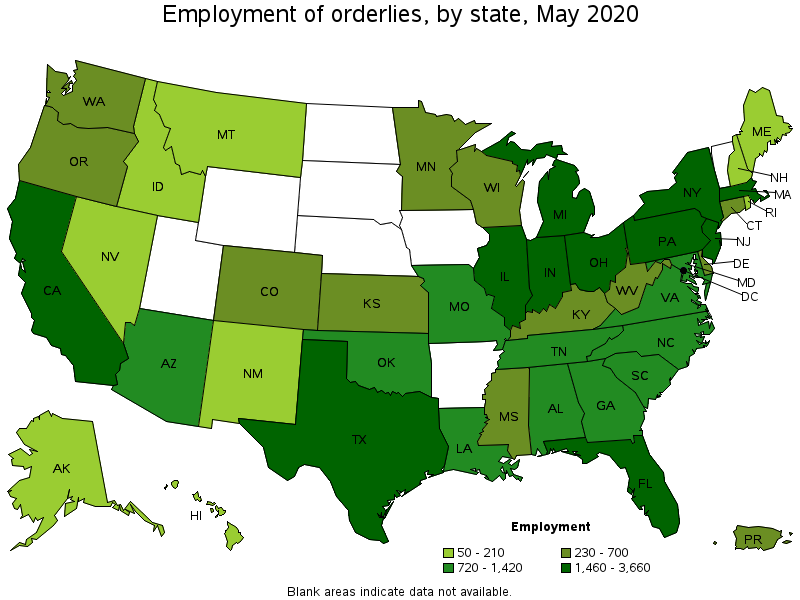
States with the highest employment level in Orderlies:
| State | Employment (1) | Employment per thousand jobs | Location quotient (9) | Hourly mean wage | Annual mean wage (2) |
|---|---|---|---|---|---|
| California | 3,660 | 0.22 | 0.71 | $ 21.07 | $ 43,830 |
| New York | 3,210 | 0.37 | 1.18 | $ 19.20 | $ 39,940 |
| New Jersey | 2,800 | 0.74 | 2.36 | $ 15.86 | $ 32,990 |
| Texas | 2,530 | 0.21 | 0.67 | $ 13.05 | $ 27,140 |
| Pennsylvania | 2,500 | 0.45 | 1.45 | $ 14.58 | $ 30,330 |
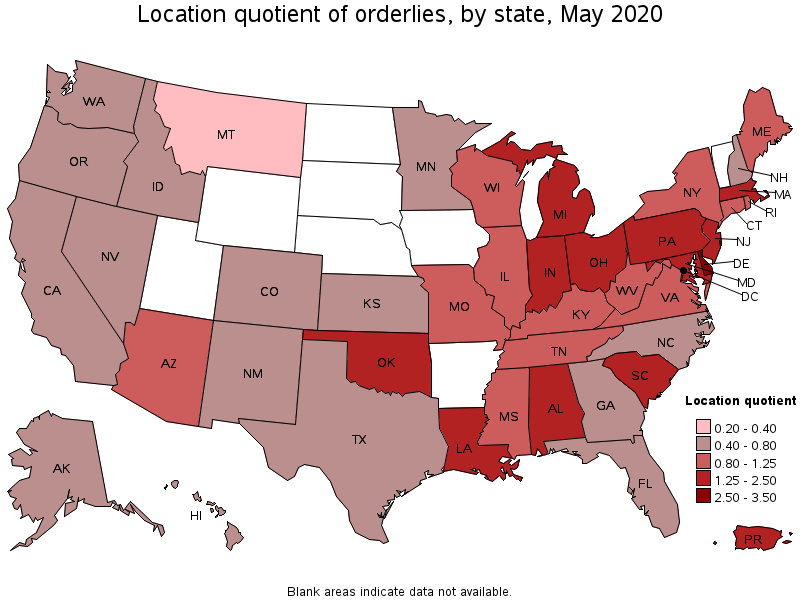
States with the highest concentration of jobs and location quotients in Orderlies:
| State | Employment (1) | Employment per thousand jobs | Location quotient (9) | Hourly mean wage | Annual mean wage (2) |
|---|---|---|---|---|---|
| Delaware | 390 | 0.91 | 2.91 | $ 16.43 | $ 34,180 |
| New Jersey | 2,800 | 0.74 | 2.36 | $ 15.86 | $ 32,990 |
| Maryland | 1,420 | 0.56 | 1.79 | $ 14.21 | $ 29,550 |
| Louisiana | 1,000 | 0.55 | 1.77 | $ 11.40 | $ 23,710 |
| South Carolina | 1,110 | 0.55 | 1.75 | $ 12.39 | $ 25,760 |
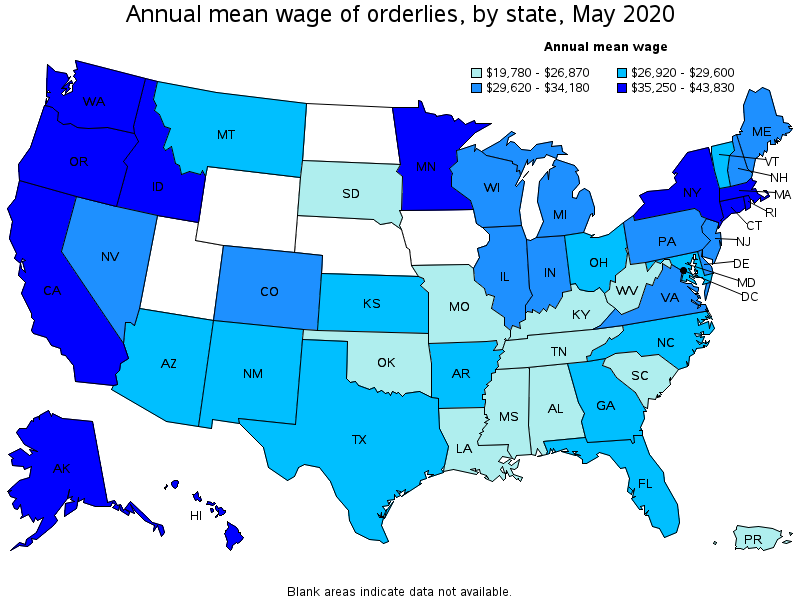
Top paying states for Orderlies:
| State | Employment (1) | Employment per thousand jobs | Location quotient (9) | Hourly mean wage | Annual mean wage (2) |
|---|---|---|---|---|---|
| California | 3,660 | 0.22 | 0.71 | $ 21.07 | $ 43,830 |
| Hawaii | 90 | 0.16 | 0.51 | $ 19.68 | $ 40,940 |
| New York | 3,210 | 0.37 | 1.18 | $ 19.20 | $ 39,940 |
| Minnesota | 650 | 0.24 | 0.77 | $ 18.85 | $ 39,200 |
| Alaska | 70 | 0.24 | 0.76 | $ 18.50 | $ 38,480 |
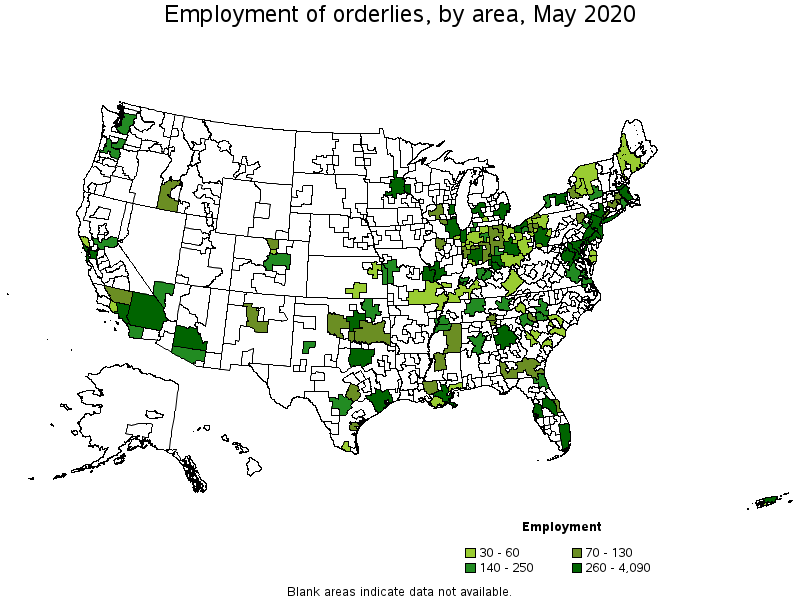
Metropolitan areas with the highest employment level in Orderlies:
| Metropolitan area | Employment (1) | Employment per thousand jobs | Location quotient (9) | Hourly mean wage | Annual mean wage (2) |
|---|---|---|---|---|---|
| New York-Newark-Jersey City, NY-NJ-PA | 4,090 | 0.46 | 1.48 | $ 18.43 | $ 38,330 |
| Philadelphia-Camden-Wilmington, PA-NJ-DE-MD | 1,820 | 0.67 | 2.15 | $ 15.42 | $ 32,070 |
| Chicago-Naperville-Elgin, IL-IN-WI | 1,560 | 0.36 | 1.14 | $ 15.37 | $ 31,960 |
| Los Angeles-Long Beach-Anaheim, CA | 1,400 | 0.24 | 0.77 | $ 19.27 | $ 40,080 |
| Boston-Cambridge-Nashua, MA-NH | 1,140 | 0.44 | 1.40 | $ 17.55 | $ 36,510 |
| Houston-The Woodlands-Sugar Land, TX | 950 | 0.32 | 1.02 | $ 13.57 | $ 28,220 |
| Detroit-Warren-Dearborn, MI | 920 | 0.52 | 1.65 | $ 14.88 | $ 30,950 |
| Baltimore-Columbia-Towson, MD | 870 | 0.67 | 2.15 | $ 13.72 | $ 28,530 |
| Washington-Arlington-Alexandria, DC-VA-MD-WV | 770 | 0.25 | 0.81 | $ 15.24 | $ 31,700 |
| St. Louis, MO-IL | 720 | 0.56 | 1.78 | $ 12.75 | $ 26,520 |
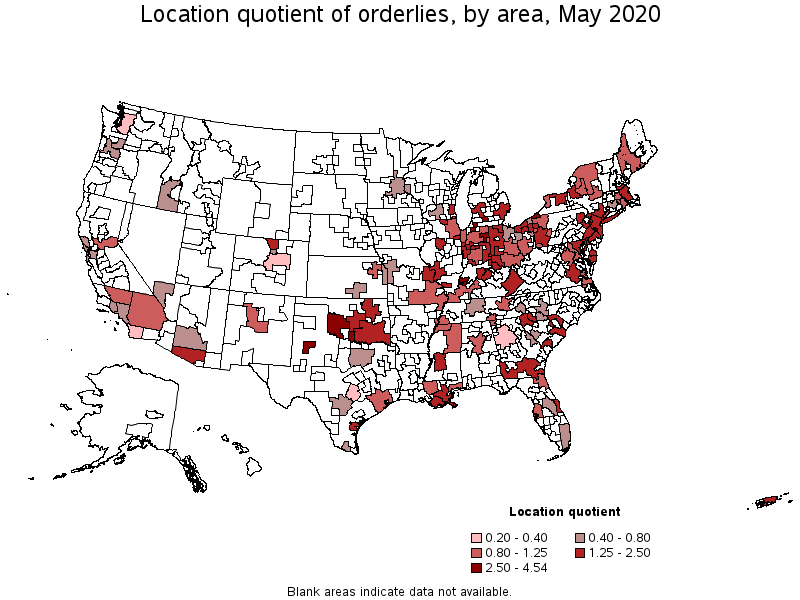
Metropolitan areas with the highest concentration of jobs and location quotients in Orderlies:
| Metropolitan area | Employment (1) | Employment per thousand jobs | Location quotient (9) | Hourly mean wage | Annual mean wage (2) |
|---|---|---|---|---|---|
| South Bend-Mishawaka, IN-MI | 150 | 1.17 | 3.74 | $ 14.46 | $ 30,080 |
| Lubbock, TX | 150 | 1.09 | 3.47 | $ 11.11 | $ 23,110 |
| Evansville, IN-KY | 160 | 1.06 | 3.38 | $ 14.44 | $ 30,030 |
| Trenton, NJ | 230 | 1.01 | 3.23 | (8) | (8) |
| Erie, PA | 110 | 1.01 | 3.21 | $ 13.42 | $ 27,900 |
| Battle Creek, MI | 40 | 0.91 | 2.92 | $ 12.69 | $ 26,390 |
| Fort Wayne, IN | 180 | 0.87 | 2.78 | $ 14.51 | $ 30,170 |
| Rockford, IL | 100 | 0.76 | 2.42 | $ 13.85 | $ 28,820 |
| Kankakee, IL | 30 | 0.72 | 2.28 | $ 14.06 | $ 29,250 |
| Corpus Christi, TX | 130 | 0.71 | 2.28 | $ 12.13 | $ 25,240 |
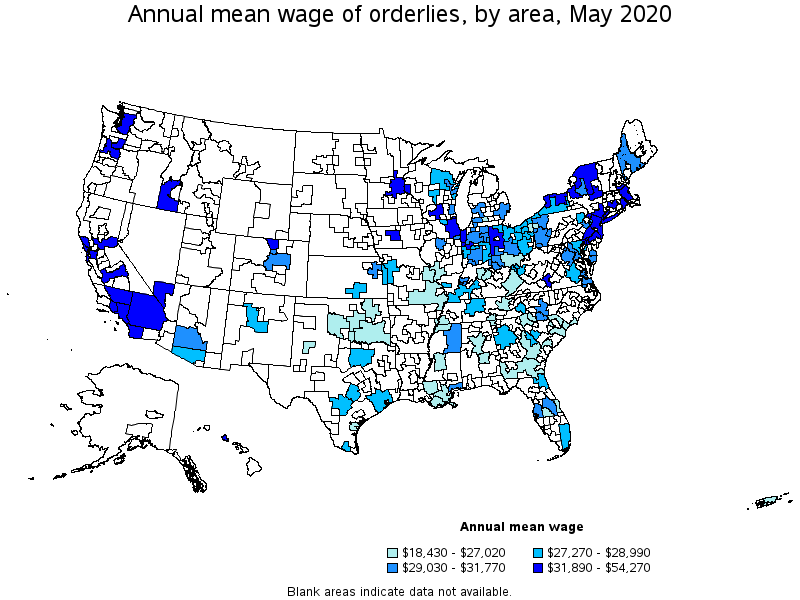
Top paying metropolitan areas for Orderlies:
| Metropolitan area | Employment (1) | Employment per thousand jobs | Location quotient (9) | Hourly mean wage | Annual mean wage (2) |
|---|---|---|---|---|---|
| Sacramento--Roseville--Arden-Arcade, CA | 250 | 0.25 | 0.81 | $ 26.09 | $ 54,270 |
| San Francisco-Oakland-Hayward, CA | 400 | 0.17 | 0.55 | $ 24.80 | $ 51,580 |
| Riverside-San Bernardino-Ontario, CA | 510 | 0.34 | 1.09 | $ 24.60 | $ 51,170 |
| Santa Rosa, CA | 30 | 0.18 | 0.57 | $ 20.89 | $ 43,460 |
| Minneapolis-St. Paul-Bloomington, MN-WI | 300 | 0.16 | 0.51 | $ 20.55 | $ 42,750 |
| Oxnard-Thousand Oaks-Ventura, CA | 60 | 0.19 | 0.60 | $ 20.03 | $ 41,670 |
| Urban Honolulu, HI | (8) | (8) | (8) | $ 19.79 | $ 41,160 |
| Bakersfield, CA | 80 | 0.26 | 0.84 | $ 19.28 | $ 40,090 |
| Los Angeles-Long Beach-Anaheim, CA | 1,400 | 0.24 | 0.77 | $ 19.27 | $ 40,080 |
| San Diego-Carlsbad, CA | 140 | 0.10 | 0.31 | $ 18.66 | $ 38,810 |
Nonmetropolitan areas with the highest employment in Orderlies:
| Nonmetropolitan area | Employment (1) | Employment per thousand jobs | Location quotient (9) | Hourly mean wage | Annual mean wage (2) |
|---|---|---|---|---|---|
| West Northwestern Ohio nonmetropolitan area | 130 | 0.54 | 1.74 | $ 16.73 | $ 34,800 |
| South Georgia nonmetropolitan area | 90 | 0.50 | 1.61 | $ 10.78 | $ 22,430 |
| Southwest Oklahoma nonmetropolitan area | 90 | 1.42 | 4.54 | $ 10.21 | $ 21,250 |
| Central Indiana nonmetropolitan area | 80 | 0.52 | 1.66 | $ 13.42 | $ 27,920 |
| Southeast Oklahoma nonmetropolitan area | 70 | 0.45 | 1.44 | $ 12.18 | $ 25,340 |
Nonmetropolitan areas with the highest concentration of jobs and location quotients in Orderlies:
| Nonmetropolitan area | Employment (1) | Employment per thousand jobs | Location quotient (9) | Hourly mean wage | Annual mean wage (2) |
|---|---|---|---|---|---|
| Southwest Oklahoma nonmetropolitan area | 90 | 1.42 | 4.54 | $ 10.21 | $ 21,250 |
| Northeast South Carolina nonmetropolitan area | 50 | 0.55 | 1.75 | $ 11.51 | $ 23,930 |
| West Northwestern Ohio nonmetropolitan area | 130 | 0.54 | 1.74 | $ 16.73 | $ 34,800 |
| Central Indiana nonmetropolitan area | 80 | 0.52 | 1.66 | $ 13.42 | $ 27,920 |
| South Georgia nonmetropolitan area | 90 | 0.50 | 1.61 | $ 10.78 | $ 22,430 |
Top paying nonmetropolitan areas for Orderlies:
| Nonmetropolitan area | Employment (1) | Employment per thousand jobs | Location quotient (9) | Hourly mean wage | Annual mean wage (2) |
|---|---|---|---|---|---|
| West Northwestern Ohio nonmetropolitan area | 130 | 0.54 | 1.74 | $ 16.73 | $ 34,800 |
| Capital/Northern New York nonmetropolitan area | 40 | 0.27 | 0.85 | $ 15.58 | $ 32,410 |
| Western Pennsylvania nonmetropolitan area | 40 | 0.26 | 0.84 | $ 14.92 | $ 31,040 |
| Northern Indiana nonmetropolitan area | 60 | 0.31 | 0.99 | $ 14.90 | $ 30,990 |
| Southwest Maine nonmetropolitan area | 60 | 0.35 | 1.11 | $ 14.77 | $ 30,710 |
These estimates are calculated with data collected from employers in all industry sectors, all metropolitan and nonmetropolitan areas, and all states and the District of Columbia. The top employment and wage figures are provided above. The complete list is available in the downloadable XLS files.
The percentile wage estimate is the value of a wage below which a certain percent of workers fall. The median wage is the 50th percentile wage estimate—50 percent of workers earn less than the median and 50 percent of workers earn more than the median. More about percentile wages.
(1) Estimates for detailed occupations do not sum to the totals because the totals include occupations not shown separately. Estimates do not include self-employed workers.
(2) Annual wages have been calculated by multiplying the hourly mean wage by a "year-round, full-time" hours figure of 2,080 hours; for those occupations where there is not an hourly wage published, the annual wage has been directly calculated from the reported survey data.
(3) The relative standard error (RSE) is a measure of the reliability of a survey statistic. The smaller the relative standard error, the more precise the estimate.
(7) The value is less than .005 percent of industry employment.
(8) Estimate not released.
(9) The location quotient is the ratio of the area concentration of occupational employment to the national average concentration. A location quotient greater than one indicates the occupation has a higher share of employment than average, and a location quotient less than one indicates the occupation is less prevalent in the area than average.
Other OEWS estimates and related information:
May 2020 National Occupational Employment and Wage Estimates
May 2020 State Occupational Employment and Wage Estimates
May 2020 Metropolitan and Nonmetropolitan Area Occupational Employment and Wage Estimates
May 2020 National Industry-Specific Occupational Employment and Wage Estimates
Last Modified Date: March 31, 2021